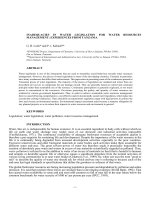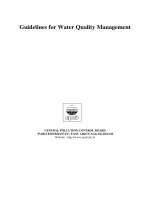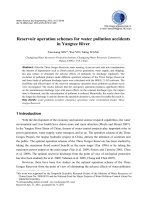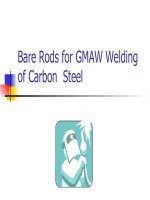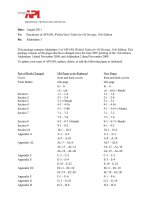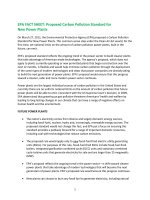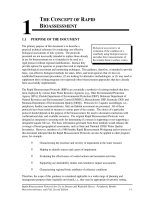AWWA d100 2005 welded carbon steel tanks for water storage
Bạn đang xem bản rút gọn của tài liệu. Xem và tải ngay bản đầy đủ của tài liệu tại đây (6.74 MB, 256 trang )
The Authoritative Resource on Safe Water
SM
ANSI/AWWA D100-05
(Revision of ANSI/AWWA D100-96)
AWWA Standard
Effective date: May 1, 2006.
First edition approved by AWWA Board of Directors June 23, 1991.
This edition approved June 12, 2005.
Approved by American National Standards Institute Oct. 19, 2005.
Welded Carbon Steel
Tanks for Water Storage
Advocacy
Communications
Conferences
Education and Training
᭤ Science and Technology
Sections
6666 West Quincy Avenue
Denver, CO 80235-3098
T 800.926.7337
www.awwa.org
ii
AWWA Standard
This document is an American Water Works Association (AWWA) standard. It is not a specification. AWWA standards
describe minimum requirements and do not contain all of the engineering and administrative information normally
contained in specifications. The AWWA standards usually contain options that must be evaluated by the user of the
standard. Until each optional feature is specified by the user, the product or service is not fully defined. AWWA
publication of a standard does not constitute endorsement of any product or product type, nor does AWWA test, certify,
or approve any product. The use of AWWA standards is entirely voluntary. AWWA standards are intended to represent a
consensus of the water supply industry that the product described will provide satisfactory service. When AWWA revises
or withdraws this standard, an official notice of action will be placed on the first page of the classified advertising
section of Journal AWWA. The action becomes effective on the first day of the month following the month of Journal
AWWA publication of the official notice.
American National Standard
An American National Standard implies a consensus of those substantially concerned with its scope and provisions. An
American National Standard is intended as a guide to aid the manufacturer, the consumer, and the general public. The
existence of an American National Standard does not in any respect preclude anyone, whether that person has
approved the standard or not, from manufacturing, marketing, purchasing, or using products, processes, or procedures
not conforming to the standard. American National Standards are subject to periodic review, and users are cautioned
to obtain the latest editions. Producers of goods made in conformity with an American National Standard are
encouraged to state on their own responsibility in advertising and promotional materials or on tags or labels that the
goods are produced in conformity with particular American National Standards.
C
AUTION NOTICE: The American National Standards Institute (ANSI) approval date on the front cover of this standard
indicates completion of the ANSI approval process. This American National Standard may be revised or withdrawn at
any time. ANSI procedures require that action be taken to reaffirm, revise, or withdraw this standard no later than five
years from the date of publication. Purchasers of American National Standards may receive current information on all
standards by calling or writing the American National Standards Institute, 25 West 43rd Street, Fourth Floor, New York,
NY 10036; (212) 642-4900.
Science and Technology
AWWA unites the entire water community by developing and distributing authoritative scientific and technological
knowledge. Through its members, AWWA develops industry standards for products and processes that advance public
health and safety. AWWA also provides quality improvement programs for water and wastewater utilities.
All rights reserved. No part of this publication may be reproduced or transmitted in any form or by any means, electronic
or mechanical, including photocopy, recording, or any information or retrieval system, except in the form of brief
excerpts or quotations for review purposes, without the written permission of the publisher.
Copyright © 2006 by American Water Works Association
Printed in USA
标准分享网 www.bzfxw.com 免费下载
iii
Committee Personnel
The D100 Revision Task Force that developed this standard had the following personnel at
the time:
Gregory A. Larson, Chair
General Interest
R.G. Biale, Resource Development Company, Sparks, Nev. (AWWA)
J.R. Buzek, AEC Engineering Inc., Minneapolis, Minn. (AWWA)
W. Kerns, Black & Veatch, Kansas City, Mo. (AWWA)
Y.T. Lin, Alvord Burdick & Howson LLC, Chicago, Ill. (AWWA)
L.R. Todd, Consultant, Paso Robles, Calif. (AWWA)
C.C. Sundberg, CH2M Hill Inc., Issaquah, Wa. (AWWA)
Producer Members
D.G. Cull, C T Services Inc., Jeffersonville, Ind. (AWWA)
R.B. Kern, Ultraflote Corporation, Houston, Texas (AWWA)
B.E. Kromer, Tank Builders Inc., Euless, Texas (AWWA)
C.D. Lakin, Phoenix Fabricators & Erectors, Inc., Avon, Ind. (AWWA)
G.A. Larson, CB&I Constructors Inc., Clive, Iowa (AWWA)
T.J. McCandless,
*
Standards Engineer Liaison, Denver, Colo. (AWWA)
S.W. Meier, Tank Industry Consultants Inc., Indianapolis, Ind. (AWWA)
J.E. Noren, Advance Tank and Construction Company, Wellington, Colo. (AWWA)
L.D. Scott, CB&I Trusco Tank, San Luis Obispo, Calif. (AWWA)
D.L. Stilger, Caldwell Tanks Inc., Louisville, Ky. (AWWA)
R.S. Wozniak, Bow Tech Ltd., Louisville, Ky. (AWWA)
User Member
J. Asner, Washington Suburban Sanitary Commission, Laurel, Md. (AWWA)
*Liaison, nonvoting
iv
The Standards Committee on Steel Elevated Tanks, Standpipes, and Reservoirs that
reviewed and approved this standard had the following personnel at the time of approval:
Stephen W. Meier, Chair
General Interest Members
J.R. Buzek, AEC Engineering Inc. Minneapolis, Minn. (AWWA)
B.R. Conklin, Camp Dresser & McKee Inc., Cambridge, Mass. (NEWWA)
E. Darrimon, Bay Area Coating Consultant Service Inc., Denair, Calif. (AWWA)
W.J. Dixon, Dixon Engineering Inc., Lake Odessa, Mich. (AWWA)
T.J. McCandless,
*
Standards Engineer Liaison, Denver, Colo. (AWWA)
S.W. Meier, Tank Industry Consultants, Indianapolis, Ind. (AWWA)
H.J. Miedema, William Frost & Associates, Irvine, Calif. (AWWA)
L.F. Peters, Melrose, Mass. (AWWA)
J.E. Rudina, Mazda Consultants Inc., Saint Paul, Minn. (AWWA)
C.C. Sundberg, CH2M Hill Inc., Issaquah, Wash. (AWWA)
P. T. T i e r n e y,
*
Standards Council Liaison, Greater Cincinnati
Water Works, Cincinnati, Ohio (AWWA)
J.H. Wilber, American AVK Company, Littleton, Colo. (AWWA)
R.S. Wozniak, BowTech Inc., Batavia, Ill. (AWWA)
Producer Members
M. Bauer, Tnemec Company Inc., Kansas City, Mo. (AWWA)
D.G. Cull, C T Services Inc., Jeffersonville, Ind. (AWWA)
J.C. Ellrich, Mid Atlantic Storage Systems Inc., Washington
Court House, Ohio. (AWWA)
B.E. Kromer, Tank Builders Inc., Euless, Texas (SPFA)
D.H. Kroon, Corrpro Companies Inc., Houston, Texas (AWWA)
G.A. Larson, CB&I Constructors Inc., Clive, Iowa (AWWA)
*Liaison, nonvoting
标准分享网 www.bzfxw.com 免费下载
v
K. McGuire, Columbian Tectank Inc., Parson, Kan. (AWWA)
L.D. Scott,
*
CB&I Trusco Tank Inc., San Luis Obispo, Calif. (AWWA)
D.L. Stilger, Caldwell Tanks Inc., Louisville, Ky. (AWWA)
User Members
S.F. Crumb, Fort Worth Water Department, Fort Worth, Texas (AWWA)
W.H. Harris, Houston Public Works & Engineering, Houston, Texas (AWWA)
E.J. King, Connecticut Water Company, Clinton, Conn. (AWWA)
J.L. Ortiz, East Bay Municipal Utility District, Oakland, Calif. (AWWA)
G.A. Weeks, Missouri–American Water Company, Joplin, Mo. (AWWA)
*Alternate
This page intentionally blank.
标准分享网 www.bzfxw.com 免费下载
vii
Contents
All AWWA standards follow the general format indicated subsequently. Some variations from this for-
mat may be found in a particular standard.
SEC. PAGE SEC. PAGE
Foreword
I Introduction xv
I.A Background xv
I.B History xv
I.C Acceptance xviii
II Special Issues xix
III Use of This Standard xix
III.A Purchaser Options and
Alternatives xx
III.B Information to Be Provided
With Bid xxvii
III.C Modification to Standard xxviii
IV Major Revisions xxviii
V Comments xxx
Standard
1 General
1.1 Scope 1
1.2 Definitions 2
1.3 Drawings to Be Provided 2
1.4 References 3
2 Materials
2.1 General 7
2.2 Material Requirements 8
3 General Design
3.1 Design Loads 11
3.2 Unit Stresses 20
3.3 Combined Stresses 23
3.4 Column, Strut, and Shell
Stability Formulas 24
3.5 Shell Girder, Intermediate
Stiffeners, and Compression
Rings 38
3.6 Roofs 40
3.7 Cylindrical Shell Plates 42
3.8 Anchorage 42
3.9 Corrosion Allowance and
Protection 48
3.10 Minimum Thickness and
Size 49
3.11 Joints 49
3.12 Weld Design Values 50
3.13 Reinforcement Around
Openings 51
3.14 Equivalent Metric Equations 53
4 Sizing and Design of Elevated Tanks
4.1 Standard Capacities 55
4.2 Heights for Elevated Tanks 55
4.3 Standard Head Range 55
4.4 Cross-Braced, Multicolumn
Elevated Tanks 55
4.5 Tank Plates 57
4.6 Pedestal Tanks 58
4.7 Tank Stability Against
Overturning 59
4.8 Lateral Load Distribution 59
5 Accessories for Elevated Tanks
5.1 Steel Riser 59
5.2 Pipe Connection 60
5.3 Overflow 60
viii
SEC. PAGE SEC. PAGE
5.4 Access 61
5.5 Vent 62
5.6 Antennas and Related
Equipment 63
5.7 Galvanic Corrosion 63
6 Sizing of Ground-Supported
Standpipes and Reservoirs 63
7 Accessories for Ground-Supported
Standpipes and Reservoirs
7.1 Flush-Type Cleanouts 63
7.2 Pipe Connections 64
7.3 Overflow 64
7.4 Access 65
7.5 Vent 66
7.6 Antennas and Related
Equipment 66
7.7 Galvanic Corrosion 67
8Welding
8.1 Definitions and Symbols 67
8.2 Qualification of Welding
Procedures, Welders, and
Welding Operators 67
8.3 Weld Joint Records 68
8.4 Butt Joints 69
8.5 Lap Joints 69
8.6 Flat Tank Bottoms Resting
Directly on Grade or
Foundation 70
8.7 Shell-to-Bottom Joint 70
8.8 Shell Plates 70
8.9 Tubular Column and Strut
Sections 70
8.10 Steel Risers 71
8.11 Roof Plates 71
8.12 Maximum Thickness of
Material to Be Welded 72
8.13 Lap Restrictions for Welded
Lap Joints 72
8.14 Minimum Size of Fillet and
Seal Welds 73
8.15 Minimum Length of Welds 73
8.16 Intermittent Welding 73
8.17 Corrosion Protection 73
9 Shop Fabrication
9.1 Workmanship 74
9.2 Straightening 74
9.3 Finish of Plate Edges—Welded
Work 74
9.4 Rolling 74
9.5 Double-Curved Plates 74
9.6 Columns 75
9.7 Shop Assembly 75
9.8 High-Strength Anchor Bolts 75
9.9 Shipping 75
10 Erection
10.1 Welds 76
10.2 Preparation of Surfaces to
Be Welded 76
10.3 Preheating Weld Joints 77
10.4 Low-Hydrogen Electrodes
and Welding Processes 78
10.5 Tack Welds 79
10.6 Tank Assembly 79
10.7 Matching Plates 81
10.8 Grouting of Column, Riser,
and Single-Pedestal Bases
for Elevated Tanks 81
标准分享网 www.bzfxw.com 免费下载
SEC. PAGE SEC. PAGE
ix
10.9 High-Strength Anchors 82
11 Inspection and Testing
11.1 General 82
11.2 Inspection Report 82
11.3 Welders’ Credentials 82
11.4 Inspection of Welded Joints 82
11.5 Number and Location of
Radiographs for Butt Weld
Joints in Tank Shells,
Load-Bearing Risers, and
Single-Pedestal Columns 86
11.6 Procedures for Inspection
of Welded-Shell Butt
Joints—Radiographic Testing 88
11.7 Procedure for Inspection of
Groove Welds in Tension
Member Bracing by Ultrasonic
Inspection 90
11.8 Inspection by Air Carbon
Arc Gouging 90
11.9 Repair of Defective Welds 91
11.10 Testing 91
12 Foundation Design
12.1 General Requirements 91
12.2 Soil-Bearing Value 92
12.3 Safety Factors 93
12.4 Foundations for Cross-Braced
Multicolumn Tanks 93
12.5 Foundations for Single-Pedestal
Tanks 95
12.6 Foundations for Ground-Supported
Flat-Bottom Tanks 96
12.7 Detail Design of Foundations 99
12.8 Concrete Design, Materials,
and Construction 100
12.9 Backfill 100
13 Seismic Design of Water Storage Tanks
13.1 General 101
13.2 Design Earthquake Ground
Motion 103
13.3 Cross-Braced, Column-Supported
Elevated Tanks 139
13.4 Pedestal-Type Elevated Tanks 141
13.5 Ground-Supported Flat-Bottom
Tanks 143
13.6 Piping Connections 154
13.7 Foundation Design for Ground-
Supported Flat-Bottom
Tanks 155
13.8 Equivalent Metric Equations 156
14 Alternative Design Basis for
Standpipes and Reservoirs
14.1 Alternative Design Basis 158
14.2 Materials 160
14.3 General Design 167
14.4 Inspection 171
14.5 Certification of Compliance 174
15 Structurally Supported Aluminum
Dome Roofs
15.1 General 174
15.2 Definition 176
15.3 Design Requirements 176
15.4 Materials 176
15.5 Allowable Stresses 177
15.6 Design 178
15.7 Roof Attachment Details 180
x
SEC. PAGE SEC. PAGE
15.8 Physical Characteristics 180
15.9 Testing and Sealing 180
15.10 Fabrication and Erection 181
15.11 Coatings 181
15.12 Equivalent Metric Equations 182
Appendixes
A Commentary for Welded
Carbon Steel Tanks for
Water Storage 183
B Default Checklist 213
Figures
1Basic Wind Speed V (From
ASCE 7) 14
2 Diagram for Checking Overturning
Stability of Pedestal-Type
Elevated Tanks (Wind or
Seismic Events) 95
3 Extreme Frost Penetration—
in Inches (Based on State
Average) 99
4 Recommended Depth of Cover
(in Feet Above Top of Pipe) 101
5 Mapped Maximum Considered
Earthquake Spectral Response
Acceleration, 5 Percent Damped,
at 0.2-sec Period S
S
for Site
Class B for the Conterminous
United States 104
6 Mapped Maximum Considered
Earthquake Spectral Response
Acceleration, 5 Percent Damped,
at 1-sec Period S
1
for Site
Class B for the Conterminous
United States 106
7 Mapped Maximum Considered
Earthquake Spectral Response
Acceleration, 5 Percent Damped,
at 0.2-sec Period S
S
for Site
Class B for Region 1 108
8 Mapped Maximum Considered
Earthquake Spectral Response
Acceleration, 5 Percent Damped,
at 1-sec Period S
1
for Site
Class B for Region 1 110
9 Mapped Maximum Considered
Earthquake Spectral Response
Acceleration, 5 Percent Damped,
at 0.2-sec Period S
S
for Site
Class B for Region 2 112
10 Mapped Maximum Considered
Earthquake Spectral Response
Acceleration, 5 Percent Damped,
at 1-sec Period S
1
for Site
Class B for Region 2 113
11 Mapped Maximum Considered
Earthquake Spectral Response
Acceleration, 5 Percent Damped,
at 0.2-sec Period S
S
for Site
Class B for Region 3 114
12 Mapped Maximum Considered
Earthquake Spectral Response
Acceleration, 5 Percent Damped,
at 1-sec Period S
1
for Site
Class B for Region 3 115
13 Mapped Maximum Considered
Earthquake Spectral Response
Acceleration, 5 Percent Damped,
at 0.2-sec Period S
S
and
1-sec Period S
1
for Site
Class B for Region 4 116
标准分享网 www.bzfxw.com 免费下载
SEC. PAGE SEC. PAGE
xi
14 Mapped Maximum Considered
Earthquake Spectral Response
Acceleration, 5 Percent
Damped, at 0.2-sec Period S
S
and 1-sec Period S
1
for Site
Class B for Hawaii 117
15 Mapped Maximum Considered
Earthquake Spectral Response
Acceleration, 5 Percent
Damped, at 0.2-sec Period S
S
for Site Class B for Alaska 118
16 Mapped Maximum Considered
Earthquake Spectral Response
Acceleration, 5 Percent
Damped, at 1-sec Period S
1
for Site Class B for Alaska 119
17 Mapped Maximum Considered
Earthquake Spectral Response
Acceleration, 5 Percent
Damped, at 0.2-sec Period S
S
and 1-sec Period S
1
for Site
Class B for Puerto Rico,
Culebra, Vieques, St. Thomas,
St. John, and St. Croix 120
18 Mapped Maximum Considered
Earthquake Spectral Response
Acceleration, 5 Percent Damped,
at 0.2-sec Period S
S
and
1-sec Period S
1
for Site Class B
for Guam and Tutuilla 121
19 Region-Dependent Transition
Period for Longer-Period
Ground Motion T
L
130
20 Deterministic Limit for
Maximum Considered Earth-
quake Ground Motion 136
21 Diagram for Checking Foundation
Stability of Cross-Braced
Column-Supported Elevated
Tanks 141
22 Bottom Piping Connection of a
Self-Anchored, Ground-Supported
Flat-Bottom Tank 156
23 Isothermal Lines for Lowest One-
Day Mean Temperatures and
Normal Daily Minimum
30°F (–1.1°C) Temperature
Line for January, United
States and Southern
Canada 164
24 Radiographic Requirements
for Tank Shells According to
Sec. 14 173
25 Certification of Compliance With
AWWA Requirements of ANSI/
AWWA D100, Sec. 14 175
A.1 Typical Undercut 201
A.2 Design Response Spectra—
General Procedure 205
A.3 Design Spectral Response
Acceleration That Causes the
Tank to Slide S
ai,slide
206
A.4 Curve for Obtaining Factor K
p
for the Ratio D/H 207
A.5 Curves for Obtaining Factors
W
i
/W
T
and W
C
/W
T
for the
Ratio D/H 208
xii
SEC. PAGE SEC. PAGE
A.6 Curves for Obtaining Factors
X
i
/H and X
c
/H for the Ratio
D/H 209
A.7 Pressure-Stabilizing Buckling
Coefficient ΔC
c
for Self-
Anchored Tanks 209
Tables
1 Thickness Limitations and
Special Requirements 9
2 Force Coefficient C
f
13
3 Velocity Pressure Exposure
Coefficient K
z
13
4 Material Classes 21
5 Unit Stresses—Tension 21
6 Unit Stresses—Compression 22
7 Unit Stresses—Primary Bending 22
8 Unit Stresses—Shearing 23
9 Unit Stresses—Bearing 23
10 Allowable Local Buckling
Compressive Stress F
L
for
Class 1 Materials 29
11 Allowable Local Buckling
Compressive Stress F
L
for
Class 2 Materials 30
12 Allowable Axial Compressive
Stress F
a
for Combined Effects
of Local Buckling and Slenderness
for Class 1 Materials (psi) 31
13 Allowable Axial Compressive Stress
F
a
for Combined Effects of Local
Buckling and Slenderness for
Class 2 Materials (psi) 32
14 Values of (t/R)
c
34
15 Weld Design Values—Tank
Plate Joints 43
16 Minimum Thickness of
Cylindrical Shell Plates in
Contact With Water 50
17 Standard Capacities for Elevated
Tanks 55
18 Minimum Size of Fillet Weld—
Shell-to-Bottom Joint 71
19 Minimum Diameter for
Unrolled Shell Plates for
Elevated Tanks 75
20 Maximum Thickness of
Reinforcement for Butt Joints 77
21 Roundness—Cylindrical Shells 80
22 Maximum Allowable Offset of
Aligned Butt Joints 81
23 Maximum Height of Weld
Reinforcement of Weld for Butt
Joints Above Plate Surface 89
24 Seismic Importance Factor I
E
103
25 Site Class Definitions 122
26 Short-Period Site Coefficient F
a
126
27 Long-Period Site Coefficient F
v
126
28 Response Modification Factors
R
i
and R
c
127
29 Minimum Freeboard
Requirements 153
30 Minimum Design Displacements
for Piping Attachments 155
31 Category 1 Material Requirements
for Shell Plates in Contact
With Water to Be Used for
Design Metal Temperature
Tabulated 162
标准分享网 www.bzfxw.com 免费下载
SEC. PAGE SEC. PAGE
xiii
32 Category 2 Materials 163
33 Category 3 Materials 163
34 Maximum Design Tensile
Stresses in Shell Plates in
Contact With Water 169
35 Minimum Thickness of
Bottom Annulus 171
36 Bolts and Fasteners 178
A.1 Seismic Use Group 204
This page intentionally blank.
标准分享网 www.bzfxw.com 免费下载
xv
Foreword
This foreword is for information only and is not a part of AWWA D100.
I. Introduction.
I.A. Background. In 1931, American Water Works Association (AWWA)
Subcommittee 7H, whose members were L.R. Howson, H.C. Boardman, and James
O. Jackson, prepared “Standard Specifications for Riveted Steel Elevated Tanks and
Standpipes.” The specifications were published in the November 1935 edition of
Journal AWWA. In 1940, the scope of the standard specifications was expanded to
include welded construction. The American Welding Society (AWS)
*
cooperated in
the revision and became a joint sponsor of the standard. Since its original
publication, the standard has gained wide acceptance in the United States and
abroad.
I.B. History. In 1965, appendix C was added to provide for the alternative use
of higher-strength steels for standpipes and reservoirs. Other changes included the
addition of requirements for the use of steel pipe as tubular columns, and a wind–
pressure formula for winds in excess of 100 mph (45 m/sec). The requirements for
loads on balconies and ladders and unit stresses for combinations of wind, seismic,
and other loads were clarified. The rules for the minimum thickness of shell plates for
standpipes and reservoirs were revised to apply only to cylindrical shells and not to
knuckles or toroidal or elliptical roof plates containing water. The swivel ladder for
standpipes and reservoirs, which was found to be impractical, was eliminated, and a
fixed ladder was required. The rules for welding and for weld qualification were
rewritten completely. The qualification procedure of the American Society of
Mechanical Engineers (ASME)
†
Boiler and Pressure Vessel Code, Sec. IX, was
adopted, and the sizes of fillet welds in the shell-to-bottom joints of standpipes and
reservoirs were revised, as were the sections on sand cushions and grouting for
standpipe and reservoir bottoms. Rules for inspection of welds were rewritten
completely. An isothermal map showing the lowest one-day mean temperature in
various parts of the continental United States and parts of Canada was included.
Concrete foundation design was brought into conformity with American Concrete
*American Welding Society, 550 N.W. LeJeune Road, Miami, FL 33126.
†ASME International, Three Park Avenue, New York, NY 10016.
xvi
Institute (ACI)
*
Standard No. 318, Building Code Requirements for Reinforced
Concrete.
In 1973, the use of rivets for joints in tank shells was eliminated. Specifications
for tank steels were revised to include low-alloy steels. The design of foundations for
elevated tanks and standpipes was changed extensively, making foundation design a
part of the requirements. Procedures for soil investigation were recommended.
In 1979, appendix A, Non-Mandatory Seismic Design of Water Storage Tanks,
and appendix B, Diagrams for Checking Overturning of Elevated Tanks, were added.
The sections from the former appendix B, covering information to be provided, were
incorporated into Sec. II of the foreword, and the sections dealing with foundations
were incorporated into Sec. 12. Section 11 was revised to include inspection and
testing requirements that were formerly in Sec. 11 and Sec. 12 and appendixes A and
B. Other additions included requirements for additional acceptable steels, design
requirements for seismic resistance, a formula for cylindrical shell design, require-
ments for backfill within ringwall foundations, and requirements for depth-of-pipe
cover. The out-of-date porosity charts in former appendix A were eliminated and
reference made to the charts in the ASME Boiler and Pressure Vessel Code, Sec. VIII,
or to the identical charts in American Petroleum Institute (API)
†
Standard 650,
Welded Steel Tanks for Oil Storage. A section covering permissible inspection by air
carbon arc gouging was added to Sec. 11. Materials for shell plates and intermediate
stiffeners were classified into three categories in appendix C, and the requirements for
impact testing were expanded.
In 1984, revisions included new sections pertaining to single-pedestal tanks
incorporating design rules for this type of tank. New design rules were included for
columns of elevated tanks having eccentric work-point connections. A section
covering the design considerations for struts was added. For combined stresses,
the unit stresses for wind and seismic forces were increased from 25 percent to
33
1
/3 percent. Shell plates thicker than 2 in. (51 mm), conforming to American
Society for Testing and Materials (ASTM)
‡
A36, Specification for Structural Steel,
were allowed to be used, provided their usage was in compliance with certain
stipulated conditions and requirements. Ground-supported tanks not greater than
*ACI International, 38800 Country Club Drive, Farmington Hills, MI 48333.
†American Petroleum Institute, 1220 L Street, NW, Washington, DC 20005.
‡ASTM International, 100 Barr Harbor Drive, West Conshohocken, PA 19428.
标准分享网 www.bzfxw.com 免费下载
xvii
50 ft (15.2 m) in diameter were allowed to have a minimum shell thickness of
3
/16 in.
(7.9 mm). A minimum size and maximum spacing were added for foundation bolts.
The previous appendix A, on seismic design, was incorporated into the standard as
Sec. 13. In addition, a new section was added to Sec. 13 to permit scaling down to
specific site response spectra when local seismic data are available.
Appendix C, Alternative Rules and Design Stresses for the Use of Steel Plates and
Shapes With Suitable Toughness and Ductility for Use in Welded Standpipes and
Reservoirs at Specified Minimum Ambient Temperatures, was made a part of the
standard while retaining its title designation as appendix C.
For appendix C tanks with a height-to-diameter (H/D) ratio of 0.50 or less, the
shell design was allowed to be by the Variable Design Point Method, in compliance
with API 650. Also, for appendix C tanks, inspection of certain members is not
required when the material has a tensile strength less than 75,000 psi (517.1 MPa).
In 1996, revisions included new requirements for high-strength anchor bolts.
Table 1 was added to clarify thickness limitations and special material requirements.
Requirements for wind escalation for heights greater than 125 ft (38.1 m) and wind
loads on shrouds were added. Fixed-percentage seismic design loads were eliminated.
Design requirements for handrails and guardrails were added. Allowable-unit stresses
were stated as a function of material class, which is a function of material yield
strength. Width-to-thickness limitations were added for compression elements, and
compression requirements for shells were clarified. Design rules for tension and
compression rings were added. Anchorage requirements were expanded and a wind
overturning check for ground-supported tanks was added. Weld inspection for
tension bracing for cross-braced, column-supported elevated tanks was expanded to
include ultrasonic testing and tensile tests. Requirements for flush-type cleanout
fittings for ground-supported flat-bottom tanks were added. Design rules and limits
for openings in support pedestals were added. Criteria for accessories including safety
grills, overflows, and vents were updated. Seal welds were defined and usage clarified.
Temperature requirements for welding and weld reinforcement limits were added.
Tolerances were added for ground-supported tanks and shells designed by stability
formulas. Responsibilities of the certified welding inspector were defined. Inspection
requirements for primary and secondary stressed joints, and tubular support columns
were clarified. Inspection requirements were added for single-pedestal columns and
large-diameter dry risers. The penetrometer techniques and details were revised to
conform to ASME criteria.
xviii
The load factor to be applied to water load for foundation design was clarified,
and requirements for material under bottom plates of ground-supported tanks were
added.
Seismic design load equations were revised to follow the Uniform Building Code
*
format. A new seismic map of the United States was included along with new and
revised equations for calculating such things as hydrodynamic seismic hoop tensile
stresses and sloshing wave height to determine minimum freeboard for ground-
supported flat-bottom tanks.
Appendix C of the previous edition was incorporated in the standard as Sec. 14,
and reference standards were moved to Sec. 1. Electrode criteria and requirements for
permanent and temporary attachment criteria were revised. The type of inspection
and number of weld-joint inspections were updated to improve quality control.
A new Sec. 15, entitled Structurally Supported Aluminum Dome Roofs, was
added.
The major revisions in this edition are summarized in Sec. IV of this foreword.
This edition was approved by the AWWA Board of Directors on June 12, 2005.
I.C. Acceptance. In May 1985, the US Environmental Protection Agency
(USEPA) entered into a cooperative agreement with a consortium led by NSF
International (NSF) to develop voluntary third-party consensus standards and a
certification program for all direct and indirect drinking water additives. Other
members of the original consortium included the American Water Works Association
Research Foundation (AwwaRF) and the Conference of State Health and Environ-
mental Managers (COSHEM). The American Water Works Association (AWWA)
and the Association of State Drinking Water Administrators (ASDWA) joined later.
In the United States, authority to regulate products for use in, or in contact with,
drinking water rests with individual states.
†
Local agencies may choose to impose
requirements more stringent than those required by the state. To evaluate the health
effects of products and drinking water additives from such products, state and local
agencies may use various references, including
1. An advisory program formerly administered by USEPA, Office of Drinking
Water, discontinued on Apr. 7, 1990.
*Uniform Building Code, International Conference of Building Officials, 5360 Workman Mill
Road, Whittier, CA 90601.
†Persons outside the United States should contact the appropriate authority having jurisdiction.
标准分享网 www.bzfxw.com 免费下载
xix
2. Specific policies of the state or local agency.
3. Two standards developed under the direction of NSF, NSF
*
/ANSI
†
60,
Drinking Water Treatment Chemicals—Health Effects, and ANSI/NSF 61, Drinking
Water System Components—Health Effects.
4. Other references, including AWWA standards, Food Chemicals Codex, Water
Chemicals Codex,
‡
and other standards considered appropriate by the state or local
agency.
Various certification organizations may be involved in certifying products in
accordance with ANSI/NSF 61. Individual states or local agencies have authority to
accept or accredit certification organizations within their jurisdiction. Accreditation
of certification organizations may vary from jurisdiction to jurisdiction.
Annex A, “Toxicology Review and Evaluation Procedures,” to ANSI/NSF 61 does
not stipulate a maximum allowable level (MAL) of a contaminant for substances not
regulated by a USEPA final maximum contaminant level (MCL). The MALs of an
unspecified list of “unregulated contaminants” are based on toxicity testing guidelines
(noncarcinogens) and risk characterization methodology (carcinogens). Use of Annex A
procedures may not always be identical, depending on the certifier.
ANSI/AWWA D100-05 does not address additives requirements. Users of this
standard should consult the appropriate state or local agency having jurisdiction in
order to
1. Determine additives requirements, including applicable standards.
2. Determine the status of certifications by all parties offering to certify prod-
ucts for contact with, or treatment of, drinking water.
3. Determine current information on product certification.
II. Special Issues. This standard has no applicable information for this
section.
III. Use of This Standard. It is the responsibility of the user of an AWWA
standard to determine that the products described in that standard are suitable for use
in the particular application being considered.
*NSF International, 789 Dixboro Road, Ann Arbor, MI 48113.
†American National Standards Institute, 25 West 43rd Street, Fourth Floor, New York, NY 10036.
‡Both publications available from National Academy of Sciences, 500 Fifth Street, N.W.,
Washington, DC 20001.
xx
Contractual responsibilities for items such as design, material, fabrication,
construction, inspection, and testing have been removed from the standard and need
to be addressed by the purchaser.
This standard is based on the accumulated knowledge and experience of
purchasers and manufacturers of welded steel tanks.
*
Many tanks built in compliance with the first edition of this standard are more
than 50 years old and are still in service. Properly operated and maintained welded
steel water tanks can have an almost unlimited service life.
III.A. Purchaser Options and Alternatives Proper use of this standard requires
that the purchaser specify certain basic requirements. The purchaser may desire to
modify, delete, or amplify sections of this standard to suit special conditions. It is
strongly recommended that such modifications, deletions, or amplifications be made
by supplementing this standard. This standard is not intended to cover storage tanks
that are to be erected in areas subject to regulations that are more stringent than the
requirements contained herein. In such cases, local regulations supersede the
requirements of this standard. Where local, municipal, county, or state government
requirements exist, such requirements are to govern and this standard should be
interpreted to supplement them. It is the purchaser’s responsibility to supplement or
modify this standard for compliance with these local requirements. In addition, the
purchaser is to provide clarification of the governing codes where they do not clearly
refer to tanks, but where the purchaser intends such stipulations to apply to the tank
under contract. As an example, if a governing code stipulates a building roof snow
load of 40 lb/ft
2
(1,915 N/m
2
) and it is intended that the tank roof be designed for
this load, the purchaser is to include this as a clarification.
The details of design and construction covered by this standard are minimum
requirements. At a minimum, it is important that all of the design conditions in this
standard be met.
†
A tank cannot be represented as an ANSI/AWWA D100 tank if it
does not meet the minimum requirements of this standard.
The foundations of tanks are one of the more important aspects of tank design;
detailed requirements are covered in Sec. 12. The purchaser should obtain an
*The word “tanks” is used hereinafter broadly in place of the lengthy phrase “elevated tanks,
standpipes, and reservoirs for water storage.”
†Dawe, J.L., C.K. Seah, and A.K. Abdel-Zaher, Investigation of the Regent Street Water Tower
Collapse; Jour. AWWA, 93(5):34–47.
标准分享网 www.bzfxw.com 免费下载
xxi
adequate soil investigation at the site, including recommendation of the type of
foundation to be used, the depth of foundation required, and the design soil-bearing
pressure. This information should be established by a qualified geotechnical engineer.
A drainage-inlet structure or suitable erosion protection should be provided to
receive discharge from the tank overflow. The overflow should not be connected
directly to a sewer or a storm drain without an air break.
Annual inspection and maintenance of the exposed side of the tank shell-to-
bottom connection for a standpipe or reservoir is important if maximum tank life is
to be attained. In particular, accumulations of dirt and weeds, which may trap
moisture and accelerate corrosion, should be removed. Inspection of the interior and
exterior of the entire tank with corrective maintenance at three-year intervals is
recommended. Refer to AWWA manual M42, Steel Water-Storage Tanks, for guidance
concerning inspection and maintenance of welded steel tanks for water storage.
This standard assumes that the purchaser (owner) provides sufficient water
replacement and circulation to prevent freezing in the tank and riser pipe. Where low
usage may result in the possibility of freezing, water may need to be wasted or heat
provided to prevent freezing. The purchaser is referred to National Fire Protection
Association (NFPA)
*
document NFPA 22, Water Tanks for Private Fire Protection,
for heater sizing. Purchasers are cautioned against allowing ice buildup for insulation,
which may break loose and damage the tank.
This standard does not cover tank disinfection procedures or cleaning and
painting. ANSI/ AWWA C652, Standard for Disinfection of Water Storage Facilities,
should be consulted for recommended procedures for disinfection of water storage
facilities. Often, it is desirable for the purchaser to perform the disinfection to
eliminate the necessity for the painting constructor to return afterward or to stand by
until the inside paint has dried completely. If disinfection is to be done by either the
tank or painting constructor, the purchaser must specify the manner in which
disinfection is to be done.
The following recommendations are believed to represent good practice, but they
are not requirements of ANSI/AWWA D100. When a welded steel tank is to be
purchased under this standard, the purchaser should provide the following:
1. The site on which the tank is to be built, including sufficient space to permit
the structure to be erected by customary methods.
*National Fire Protection Associaton, 1 Battery Park, Quincy, MA 02169.
xxii
2. Water at the proper pressure for testing, as required, and facilities for dis-
posal of wastewater after testing.
3. A suitable right-of-way from the nearest public road to the erection site.
4. Materials furnished by the purchaser to be used by the constructor for con-
struction of the tank.
5. A geotechnical investigation of the project site that provides the information
listed in Sec. 12.2.1.
The constructor should provide the following items:
1. Foundation and tank design, drawings, and specifications.
2. All labor and materials, except materials provided by the purchaser, necessary
to complete the structure, including the foundations, accessories, and testing required
by this standard.
3. Any additional work, separately specified by the purchaser, such as painting
and disinfection.
Variations in the responsibilities of both the purchaser and the constructor, as
previously outlined, may be made by contractual agreement. The purchaser and the
bidder should each provide the information identified in the following listings.
III.A.1. Information to Be Provided by Purchaser for an Elevated Tank. This
standard provides minimum requirements for the design, construction, inspection,
and testing of the tank without any designation of which party must perform these
tasks. For this reason, the following items should be provided by the purchaser:
1. The standard to be used—that is, ANSI/AWWA D100, Welded Carbon
Steel Tanks for Water Storage, of latest revision.
2. Whether compliance with NSF/ANSI 61, Drinking Water System Compo-
nents—Health Effects, is required, in addition to the requirements of the Safe Drink-
ing Water Act.
3. Capacity.
4. Bottom capacity level (BCL) or top capacity level (TCL) above top of foun-
dation.
5. Type of roof.
6. Head range, if specific range is required.
7. Diameter and type of riser.
8. Location of site.
9. Desired time for completion.
10. Name of, and distance to, nearest town.
标准分享网 www.bzfxw.com 免费下载
xxiii
11. Name of, and distance to, nearest railroad siding.
12. Type of road available for access to the site and whether it is public or private.
13. Availability of electric power; who furnishes it; at what fee, if any; what volt-
age; whether direct or alternating current; and, if alternating current, what cycle and
phase.
14. Availability of compressed air; pressure, volume, and fee, if any.
15. Whether details of all welded joints are to be provided (Sec. 1.3).
16. Whether mill test reports are required (Sec. 2.1).
17. Details of other federal, state, local, and provincial requirements (Sec. 2.1).
18. Type of pipe and fittings for fluid conductors (Sec. 2.2.11), including type of
pipe joint if different from that permitted in Sec. 2.2.11.
19. Whether design snow loading may not be reduced if tank is located where
the lowest one-day mean low temperature is 5°F (–15°C) or warmer (Sec. 3.1.3.1).
20. If tank is located in a special wind region, specify the basic wind speed
(Sec. 3.1.4.1).
21. Corrosion allowance, if any, to be added to parts that will be in contact with
water and to parts that will not be in contact with water (Sec. 3.9).
22. Whether a balcony is required for inspection and painting when a horizontal
girder is not required by the tank design (Sec. 4.4.4.2).
23. Location of manholes, ladders, and any additional accessories required
(Sec. 5).
24. Number and location of pipe connections, and type and size of pipe to be
accommodated.
25. Whether a safety grill at the top of the riser is required (Sec. 5.1.1).
26. Whether a removable silt stop is required (Sec. 5.2.1).
27. Overflow type, whether stub, to ground, or (if applicable) to extend below
balcony; size of pipe; pumping and discharge rates (Sec. 5.3).
28. Whether safety cages, rest platforms, roof–ladder handrails, or other safety
devices are required and on which ladders, and whether requirements in excess of
OSHA
*
CFR Part 1910 are required (Sec. 5.4). NOTE: Purchaser is to specify
beginning location of outside tank ladder if other than at a level of 8 ft (2.4 m)
above grade (Sec. 5.4.2.2).
*Occupational Safety and Health Administration, 200 Constitution Avenue N.W., Washington,
DC 20210.
xxiv
29. Whether a special pressure-vacuum-screened vent or a pressure-vacuum
relief mechanism is required for the tank vent (Sec. 5.5.2).
30. Requirements for any additional accessories required, including provisions
for antennas and related equipment (Sec. 5.6).
31. Whether welding procedure specifications are to be provided (Sec. 8.2.1.5).
32. For butt-joint welds subject to secondary stress, whether complete joint pen-
etration is to be provided at joints in base metals of thicknesses greater than
3
/8 in.
(9.5 mm) (Sec. 8.4.2 (2)).
33. Whether seal welding is required, and if so, where it is required (Sec. 8.14.2).
34. Whether the purchaser will provide shop inspection.
35. Whether a written report is required certifying that the work was inspected
as set forth in Sec. 11.2.
36. Whether radiographic film and inspection reports must be provided (Sec. 11.2).
37. Kinds of paint or protective coatings and number of coats for inside and out-
side surfaces (see ANSI/AWWA D102, Standard for Coating Steel Water Tanks).
38. Soil investigation (Sec. 12.2.1), including foundation design criteria, type of
foundation, depth of foundation below existing grade, Site Class for seismic areas, and
design soil-bearing pressure, including factor of safety (Sec. 12.3). NOTE: Unless oth-
erwise specified, the top of foundation(s) shall be a minimum of 6 in. (150 mm)
above finish grade (Sec. 12.7.1).
39. Pile type and depth below existing grade when a pile-supported foundation
is required (Sec. 12.7.3) and provisions for establishing criteria for compensation
adjustment due to piling length changes resulting from varying subsurface conditions.
40. Whether the effect of buoyancy is to be considered in the foundation design
(Sec. 12.7.4).
41. Whether requirements of ACI 301, Specifications for Structural Concrete
for Buildings, are applicable to the concrete work (Sec. 12.8).
42. Vertical distance from finished ground level to the crown of inlet and outlet
pipe (earth cover) at riser pier (Sec. 12.9.2), if different from Figure 4.
43. Seismic Use Group for the tank (Sec. 13.2.1).
44. Whether the site-specific procedure of Sec. 13.2.8 is required.
45. Whether third-party inspection will be used by the purchaser and for which
items.
标准分享网 www.bzfxw.com 免费下载
xxv
III.A.2. Information to Be Provided by Purchaser for a Standpipe or Reservoir
(Ground-Supported Flat-Bottom Tanks). This standard provides minimum require-
ments for the design, construction, inspection, and testing of the tank without any
designation of which party must perform these tasks. For this reason, the following
items should be provided by the purchaser:
1. The standard to be used—that is, ANSI/AWWA D100, Welded Carbon
Steel Tanks for Water Storage, of latest revision.
2. Whether compliance with NSF/ANSI 61, Drinking Water System Compo-
nents—Health Effects, is required, in addition to the requirements of the Safe Drink-
ing Water Act.
3. Capacity.
4. TCL above top of foundation.
5. Type of roof.
6. Location of site.
7. Desired time for completion.
8. Name of, and distance to, nearest town.
9. Name of, and distance to, nearest railroad siding.
10. Type of road available for access to the site and whether it is public or private.
11. Availability of electric power; who furnishes it; at what fee, if any; what volt-
age; whether direct or alternating current; and, if alternating current, what cycle and
phase.
12. Availability of compressed air; pressure, volume, and fee, if any.
13. Whether details of all welded joints are to be provided (Sec. 1.3).
14. Whether mill test reports are required (Sec. 2.1).
15. Details of other federal, state, local, and provincial requirements (Sec 2.1).
16. Type of pipe and fittings for fluid conductors (Sec. 2.2.11), including type of
pipe joint if different from that permitted in Sec. 2.2.11.
17. Whether design snow loading may not be reduced if tank is located where
the lowest one-day mean low temperature is 5°F (–15°C) or warmer (Sec. 3.1.3.1).
18. If tank is located in a special wind region, specify the basic wind velocity
(Sec. 3.1.4.1).
19. Corrosion allowance, if any, to be added to parts that will be in contact with
water and to parts that will not be in contact with water (Sec. 3.9). This also applies
when a tank is to comply with Sec. 14.
20. Size and quantity of flush-type cleanouts, if required (Sec. 3.13.2.5).
